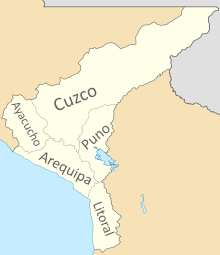Republic of South Peru
[3][9] After a trade war, the Congress of Chile approved the declaration of war on December 26, 1836,[10] claiming that Santa Cruz's rule over Peru was illegitimate, and that his influence threatened the integrity of other South American nations, as seen by Orbegoso's support for an attempted invasion of Chile by Ramón Freire, specifically pointing out that it targeted then minister Diego Portales.[11] Argentina followed suit after Juan Manuel de Rosas then declared war on the Confederation on May 19, 1837, after the escalation of a territorial conflict in its border,[12] accusing Santa Cruz of harboring supporters of the Unitarian Party.[13] South Peru was invaded from October to November under the nominal leadership of Antonio Gutiérrez de la Fuente as Supreme Chief of Peru.,[14] with the occupants being surrounded and forced to sign the a treaty, leaving the country shortly after.[10] Around the same time, North Peru seceded from the Confederation on July 30,[18] but was nevertheless attacked and defeated by the second expedition in the Battle of Portada de Guías of August 21.From 1837 to its dissolution were a Provisional President and a Congress, both with limited powers and under the control of Marshal Andrés de Santa Cruz, who was styled the Supreme Protector.

South Peru, IndianaPresidentialrepublicconfederationRamón HerreraPío de TristánOccupiedDisestablishedBoliviaBrazilSpanishPeru–Bolivian ConfederationNorth PeruPeruvian Republic1835 to 1836Peru-Bolivian ConfederationArgentinaWar of the ConfederationAgustín Gamarraunified Republic of PeruSalaverry-Santa Cruz Warcivil warFelipe Santiago SalaverryLuis José de OrbegosoAndrés de Santa Cruzera of independenceAyacuchoArequipaSouth Peru(now North) Peruvian flagCongress of TacnaPact of Tacnalegal frameworkRamón CastillaCongress of ChileSouth AmericanRamón FreireDiego PortalesJuan Manuel de Rosasdeclared warits borderUnitarian PartyinvadedAntonio Gutiérrez de la FuenteSupreme Chief of PerutreatyManuel BulnesNorth Peru secededsecond expeditionBattle of Portada de GuíasJosé de la Riva AgüeroDomingo NietoJuan Francisco de VidalrestaurateursBattle of YungayGuayaquilSacsayhuamánRamón Herrera y RodadoJuan Pío de Tristán y MoscosoSubdivisions of the Peru–Bolivian ConfederationArequipa DepartmentAyacucho DepartmentCuzco DepartmentLitoral DepartmentPuno DepartmentCongress of PeruEmpresa Editora El Comercio S. A.Ministerio de Relaciones Exteriores del PerúBasadre Grohmann, JorgeEl ComercioTamayo Herrera, JoséSamuel Augustus MitchellAtacamaCochabambaChuquisacaLa PazPotosíSanta CruzTarijaAmazonasHuaylasJunínLa LibertadLitoralCarhuaucran